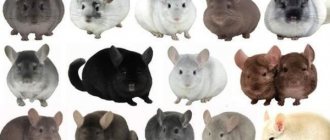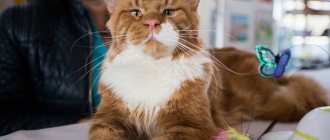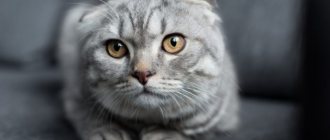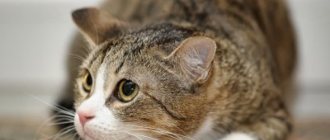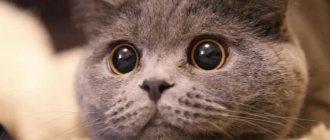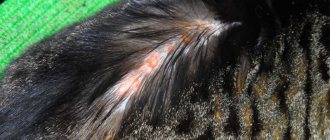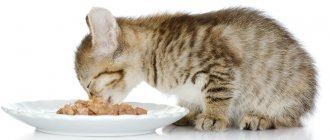Cat psychology
The main feature of the psychology of cats is their independence.
These pets cannot be forced to obey and follow commands. Walking on their own, they will only do what they want. Willfulness is not a disadvantage of mustachioed tabbies; on the contrary, cat lovers appreciate them for this. The gracefulness, grace and soft gait of the “little tiger” have inspired artists, musicians and writers for centuries. It’s not for nothing that a beautiful, spectacular woman is sometimes compared to a cat. Despite her love of freedom, a cat is capable of sincerely becoming attached to a person, and the more valuable her love will be. Cats are able to react sensitively to changes in the owner’s mood and even feel his pain. Having decided to have a cute kitten in the house, we subconsciously strive to come into contact with wild nature, because a small predator can be picked up and caressed.
A cat in the house is associated with comfort, prosperity and happiness. A purring baby curled up in a ball makes you take your mind off minor problems and gives you a feeling of warmth. There are also very playful, active cats, but their whims do not cause inconvenience and are perceived as funny little pranks. In order for living together with a cat to be joyful and comfortable, your characters must be compatible - just like people!
Tender and flexible
It is believed that black kittens are the most obedient, tender and sweet. For a long time, black cats were perceived as bringing bad luck, and centuries of hostility have taught these animals to be very sensitive and affectionate. Such a kitten will always be sociable and will easily become attached to you if he feels sincere sympathy, and will also easily find contact with the child.
However, if you are too strict with your pet, he will very quickly become nervous and withdrawn and will be afraid to do something so as not to anger you. Therefore, try not to upset the baby in vain.
Characters of cats of different breeds
The characters of cats of different breeds can be divided into 3 groups:
- sociable and sociable;
- calm and balanced;
- powerful and proud.
It is very difficult to answer the question of which cat’s character is better; it all depends on what is closer to you. Each group has its own characteristics that must be taken into account when choosing a kitten. By the way, precisely in order to know what to expect from a cat in terms of character and behavior, it is better to give preference to purebred animals. Each breed is characterized by certain well-established specific behavioral characteristics. The likelihood that a cat's behavior will correspond to expectations will be higher in pets with a pedigree.
Sociable and sociable
Cats whose characteristic feature is excessive sociability simply adore their owners! Kotofey can spend hours with his family, keep an eye on everyone and keep up the conversation with a cheerful meow - a real “life of the party.” When there is someone at home, the cat does not leave a single step from him, rubs against his legs, lies in his arms, and jumps on his shoulder. In some ways, cats of this type can even be called annoying; some consider them clingy. But here it is important that such cats are taken into the home specifically for communication, since these animals vitally need the presence of a person nearby. They have difficulty experiencing loneliness, so they are not suitable for extremely busy people who return home only to sleep. In addition, sociable cats cannot tolerate rough treatment; they only understand the language of affection.
The other side of the coin is the jealousy of cats. They become so attached to their owner that they do not want to share him with anyone - neither with other pets nor with family members.
The group of “social and sociable” cats includes the Siamese cat, German Rex, Canadian Sphynx, Oriental and Bengal cats.
Siamese cat
German Rex
Canadian Sphynx
Oriental cat
Bengal cat
Calm and balanced
The calmness and balance of these cats are the result of a very stable nervous system. Animals that belong to this subgroup by nature never show aggression. Calm cats are perfect for families with small children. Affectionate and flexible, they will never be too intrusive. Such cats do not pester people on their own, but they will gladly allow themselves to be picked up, stroked or scratched behind the ears.
However, even with such balanced cats, caution must be exercised. If you hurt them, even by accident, the result may be a sudden change in behavior - the cat will struggle, try to run away, and may inadvertently scratch or bite. To paraphrase the English poet John Dryden, let's say: “Fear the wrath of the patient cat.”
In this group, the following breeds have the most flexible character: Siberian cat, Russian Blue, American Curl, Norwegian Forest, Burmilla and Burmese cat.
Siberian cat
Russian blue cat
American Curl
Norwegian Forest Cat
Burmilla
Burmese cat
Powerful and proud
Most often, pride, independence and authority are characteristic of breeds that were developed on the basis of wild cats through direct selection. Accordingly, they retained natural habits from their wild ancestors, not least of which are the desire to dominate and self-sufficiency.
Coexisting side by side with such a cat, even for many years, one cannot say that it becomes completely domestic. Such cats do not tend to form strong attachments to humans. They would be offended by the definition of “our smaller brothers” - these are full-fledged and full-fledged members of the family, whose opinions will have to be taken into account. Cats will be docile and affectionate, but only until the moment when they themselves want to exchange mercy for anger. It is better not to have pets from this group for families with children, because it is difficult to predict the behavior of such a cat. It may simply be dangerous for a child to be near her.
On the other hand, a strong and independent cat is an excellent partner for busy people. She feels great alone and minds her own business. For the same reason, such a cat should be the only pet in the house - it has difficulty getting along with other animals.
The most popular representatives of this group are Maine Coon, British and Persian cats, Kuril and Japanese bobtails.
British Shorthair
Persian cat
Kurilian Bobtail
Japanese Bobtail
Maine Coon
Character by color
Research by zoological scientists proves an interesting fact. The colors of purebred animals influence actions, temperaments and character. Therefore, when choosing a pet, you need to pay attention to the color. It says a lot about the kitten's character. There are these types of colors:
Depending on the color of a cat’s fur, their character is determined; for example, white cats are distinguished by their kindness and affection.
- White color can be deciphered as affection, kindness and timidity.
- Goldens are calm and patient, they love to sit on hands while their fur is combed.
- Red cats are smart, endowed with intelligence, and they like to play with their owner.
- The color, like that of Siamese cats, is called color point and means sociability, affection for humans and devotion.
- Striped ones are curious, they poke their noses everywhere all their lives, they are mischievous.
- Grays are proud, independent, love freedom, walk on their own.
- Blues are friendly, sociable, and easy to make contact with.
- Marble cats are very flexible and flirtatious.
- Chocolate ones are cheerful and playful. They will not sit in one place for a long time.
- Smoky people are phlegmatic by temperament; before doing something, they will think about whether they need it.
- Tortoiseshells are loyal to their owner.
- Blacks are kind and obedient pets. There is an interesting superstition that cats of this color bring bad luck. Some people believe in him. But that's not true. They are very affectionate, strongly attached to their owners, find a common language with children and other animals (dogs, cats, hamsters). Throughout life they bring only joy to people.
Cat's temperament
In addition to what breed a cat belongs to, from birth it has a certain temperament. So, when we come to the nursery to choose a kitten, we can notice that babies from the same litter behave differently: some play and frolic on their own, some easily make contact and seem to say “pick me,” and some something hides in the corner or behind the mother cat.
By analogy with human temperaments, cats are divided into
- choleric people,
- sanguine people,
- melancholic,
- phlegmatic people.
Choleric cat
Choleric cats are characterized by a desire for vigorous activity. They are active, prone to mood swings, and react violently to new things and sounds. So, if a guest comes into the house wearing rustling clothes, the cat will not calm down for a long time. A cat can express its surprise by loud meowing and even growling.
A choleric cat will never tolerate insult and will not restrain his emotions. He will immediately hit back with his paw or bite his opponent, no matter whether it is a person, a dog or another cat. Such a fluffy dog would be suitable for an owner who leads an active lifestyle and has an explosive temperament. If there are small children in the family, you will have to be very careful with such a cat; you don’t always know what to expect from her.
Sanguine cat
A sanguine cat is ideal for the home. She quickly gets used to the new environment, gets along with other pets and loves children very much. Once in the house, the kitten will quickly adapt and begin to explore the room and will not hide in the corners. Sanguine people are playful and active, but not excessively.
But how do you get a cat with such a great character? When examining kittens from a breeder, pay attention to babies who are calmer than others. A sanguine cat has a strong constitution, will easily make contact with you, and will not squeak or scream for too long.
Phlegmatic cat
Phlegmatic cats are calm and slow. The pet will not actively demonstrate its emotions and rush around the apartment; rather, it can be called closed, restrained, and balanced. A phlegmatic cat will feel comfortable even in a small apartment, where she can sleep almost all day. If you want to play with her, the cat will most likely just watch your attempts.
This type of cat is perfect for older people, workaholics who are away from home, and those who like to while away time on the couch. The weak point of phlegmatic people is the tendency to obesity, which is a consequence of low activity. It is important to monitor your cat's diet and buy new toys that will help excite her.
Melancholic cat
Vulnerable and sensitive melancholic cats are characterized by increased anxiety. They are easily offended, they are afraid of strangers, and it takes a long time to get used to new furniture in the house. Under no circumstances should you shout at a melancholic cat, much less punish her physically. Talk to your beauty every day in a calm voice and stroke her.
The big advantage of these cats, which outweighs all the disadvantages, is their endless devotion and love for humans. They can be called monogamous. The owner becomes their friend for life.
What does temperament affect?
Here everything is exactly the same as with you and me. The brightness of emotional manifestations and the depth of an animal’s mental processes, its life rhythm, stability of mood, the degree of perception of mental phenomena, the ability to switch, reaction to events and objects, the ability to concentrate attention, the speed of thinking, the direction of perception depend on temperament (cats, like people, can be introverts and extroverts).
There are no statistics on the prevalence of this or that cat temperament. But each of them is well studied.
The character of a cat and a cat after castration and sterilization
Owners of spayed and sterilized cats note that after undergoing surgery, their pets became calmer and more balanced. Since male cats are not eager to find a partner, they do not run away from home and do not organize cat “concerts”. Animals are more flexible and affectionate, and their activity level may decrease.
However, you should not expect dramatic changes in the character of a sterilized cat or neutered cat. Pets who are not accustomed to scratching posts continue to tear up furniture, and angry furries continue to hiss and scratch. But good-natured cats will definitely maintain a positive attitude and will not sharpen their teeth on their owners.
White cats
White color is a symbol of purity and innocence. Such qualities are attributed to cats with light fur. It is believed that they are timid and vulnerable animals with the sweetest character - calm and kind. In most cases this is true. White cats are aristocratic, reverent and sensitive. They respond to their owners with the most tender affection and good manners for their kind attitude and good care. Very sensitive to people's moods. Despite their affection, white cats remain very delicate and are not intrusive.
Sometimes such love does not turn out well for them. It makes animals suspicious and suspicious of other people whom they fear. Internal anxiety negatively affects the nervous system of cats. In this state, they do not tolerate stress well and have difficulty adapting to new conditions.
As for white cats with different eyes, they differ from their ordinary counterparts in their complete unpredictability. The pet's character changes at such a speed that it is impossible to predict what will ultimately attract his curiosity and what actions he will take in the next moment. Such cats do not like the attention of strangers and loud scandals; they are very sensitive to the emotional mood of their owner.
Cunning and smart
The smartest ones, undoubtedly, are red kittens (it is no coincidence that these are the ones that scientists select to study the nervous activity of animals or for training). Animals with this coat color will be able to get used to your requirements from the very first day and will obey you. However, do not be surprised if it turns out that their obedience is just a cunning plan, and in fact the pet is simply trying to get something from you in this way.
This desire for naive deceit can, over time, even turn a kitten into a little impudent one, but still rest assured: you will never get outright hooliganism from a ginger kitten! Even if this kid does mischief, it will be only to have fun, or, even more likely, to entertain you: red cats feel very well when you are sad, and will gladly come to support you and make you laugh.
Touchy and painful
Be careful if you get a white kitten! This baby is certainly very beautiful, but be prepared for the fact that you will have to adapt to his difficult character. Such a kitten can be offended over trifles and be capricious, and white kittens are considered the most painful (in particular, they often have hearing problems). Therefore, when purchasing, carefully examine the kitten, and be prepared for the fact that you will have to visit the veterinarian quite often.
However, increased pain makes white kittens more affectionate towards their owner, because because of this they often feel insecure and are afraid that the owner will not put up with their illnesses, but will simply drive them away.
Scientific approach
So, is there any homespun truth in such statements and folk myths about cats of different colors? In order to detect it, it is necessary to seek the help of scientists, because only they can reliably prove the “color-character” connection, that is, the parallels between the genetically determined behavioral characteristics of cats and the color of their coat, which is also genetically determined. Unfortunately, this question remains open for now...
Belyaev's experiment with foxes Indirectly, the possible existence of such a connection is indicated by an experiment that is not at all connected with cats. It was carried out since 1959 by the Russian biologist D.K. Belyaev at the scientific station in Novosibirsk. The goal of the experiment, which, by the way, is still ongoing, is to breed a domesticated fox.
Only relatively loyal animals with low aggressiveness were selected for crossing. As a result, already in the fifth generation, not only the character of the foxes changed, but also the color of their fur! White spots, found in wild counterparts only on the tip of the tail and chest, decorated the domestic foxes all over the body and even scattered like stars on the face.
The results of the experiment are thought-provoking, but foxes have not yet been able to obtain such a variety of colors as in cats, which means there is little room for imagination. In the case of our pets, only the connection of red and tortoiseshell color with the gender of the animal, but not with character, has been proven so far.
READ Is it possible to give activated charcoal to a cat? Is it possible to give activated charcoal to cats Activated charcoal for a kitten with diarrhea dose
Aggression and natural selection As for the latter, everything seems to depend solely on the data of the parents, no matter what color they are. If a breeder of purebred animals does not think about selecting sires based on their character, then it is impossible to give any guarantees of the docility of the resulting offspring.
And in this sense, a kitten from the street, that is, born through natural breeding, can turn out to be much nicer and friendlier. The fact is that increased aggression in nature, and especially in the urban environment, is a factor that impedes the well-being of the animal.
Aggressive cats often die from injuries received in fights and are expelled from established street prides, which means they leave fewer offspring.
An aggressive cat is constantly in a nervous, excited state, which is why she makes mistakes, gets into life-threatening situations, and even loses kittens as a result of miscarriage, or they are born dead.
Domestic cat - what is it like?
Today, there are about 100 million domestic cats in Europe, with the largest number in Russia and France. More often they live in cities, and more than half of all modern urban cats practically do not leave the house.
Their small size and independent behavior make cats more adapted to the sedentary lifestyle of modern city dwellers. In addition, they have unique properties that make them charming pets while retaining the traits and behavior of their wild ancestors.
It is believed that during coexistence with humans, the genotype of cats has changed less than that of dogs. Both the physiology and psychology of the cat remained like that of a lone hunter, but now these animals are capable of gratitude and deep affection for the owner.
